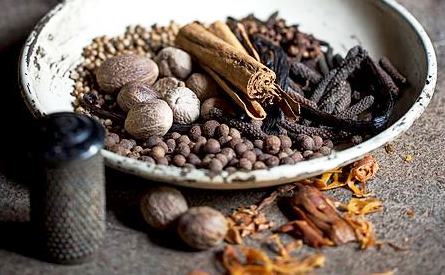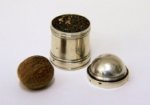There is much confusion when a recipe calls for allspice or mixed spice – and while some might consider them similar, there are distinct differences, and are not necessarily inter-changeable.
Allspice

Allspice berries are centre front in the tray. Photo © James Horan for Sydney living Museums (detail)
Allspice is one single spice – a dried berry from from the Jamaican ‘bayberry’ or ‘pimento’ tree, Pimenta dioica from the Myrtaceae family (not to be confused with the Spanish chilli or paprika pimenton). 18th-century recipes often refer to it as ‘Jamaican pepper’ as it resembles a peppercorn, but with a smoother surface. It earned the name ‘allspice’ as its flavour has dominant notes of clove with hints of cinnamon and nutmeg. It is relatively pungent and used in both sweet and savoury recipes.
‘Myrtus Pimenta’ (Pimenta dioca) from Woodville, Hooker, & Spratt ‘Medical Botany’. 3rd edn., vol. 4, 1832. Courtesy the Missouri Botanical Garden St Louis USA
Mixed spice
Mixed spice on the other hand, is a blend of spices, most usually allspice, cinnamon, clove, ginger and nutmeg, and sometimes with cassia and coriander seed; it is generally reserved for sweet dishes. In English recipes it was simply known as ‘spice’ giving some idea of its prevalence, and sometimes termed ‘English spice’ in foreign recipes, ‘sweet spice’ or, in America, ‘pudding spice’ or ‘pumpkin pie’ spice. Today we probably recognise it best in fruit loaves and raisin breads or Christmas mince pies, and giving the kitchen that distinctive ‘Christmas smell’. An early sweet spice was described by Edward Kidder in 1720 as ‘cloves, mace, nutmeg, cinnamon, sugar and salt’; the difference between sweet and savoury being apparently the addition of sugar and cinnamon in the sweet, and pepper in the savoury. No quantities are specified, as was often the case in old recipes, so cooks either had plenty of agency in their interpretation, or the flavour profile was so well known that there was an accepted taste that cooks would try and recreate. Perhaps the listing order suggests a sliding scale of quantity.
![Receipts of pastry and cookery [manuscript] : for the use of his scholars, by Ed. Kidder. p.3 © Rare Book & Manuscript Library University of Pennsylvania Ms. Codex 625](../../app/uploads/sites/2/2020/05/xkidder-1720-zoom-sweet-and-savoury-spice-mixes.png.pagespeed.ic.UkSOb4ON_u.jpg)
Receipts of pastry and cookery [manuscript] : for the use of his scholars, by Ed. Kidder. p.3 © Rare Book & Manuscript Library University of Pennsylvania Ms. Codex 625
The politics of taste
It is interesting to note the absence of allspice from Kidder’s ‘receipt’ shown above. As with many commodities, consumption is influenced by trade relations – economics and politics; money and power. In Europe ‘New World’ (South American) spices, such as chilli, vanilla and allspice had to be purchased from Spanish and Portuguese traders until the British managed to snare their own toe-hold in the region, wresting control of Jamaica in the late 1600s.This British illustration, published in 1750, calls the allspice tree ”The Bay Berry Tree… or Jamaica Pepper”:
‘The Bay Berry Tree, Myrtus arborea aromatica, or Jamaica Pepper. Plate from Hughes, ‘The Natural History of Barbados’, 1750. Image courtesy the Missouri Botanical Garden.
Kidder’s work suggests that it took some time before New World spices were adopted by English cooks, or perhaps he was slow to adopt new flavours. Jamaica pepper is mentioned in several recipes in Hannah Glasse’s The art of cookery made plain and easy, published in 1745 and was seemingly commonplace when Maria Rundell was writing up her recipes for her daughters in 1806. Mrs Beeton was clearly enamoured with allspice when writing her Book of household management (published 1861), perhaps taking the view of ‘why would you bother making a blend of spices if you could have a ‘one stop shop’ alternative? She states:
It is an inexpensive spice, and is considered more mild and innocent than most other spices; consequently, it is much used for domestic purposes, combining a very agreeable variety of flavours.
As with Indian curry, as British increased their hold in previously remote and ‘exotic’ places, allspice became acculturated into their domestic repertoire and, if Mrs Beeton is correct, cheap allspice, now a commodity of the British Empire, found its way into the classic English ‘sweet spice’ blend we now know as mixed spice.
[1] Receipts of pastry and cookery [manuscript] : for the use of his scholars / by Ed. Kidder.
For more detailed information about allspice and its other names see Herbie’s Spices



